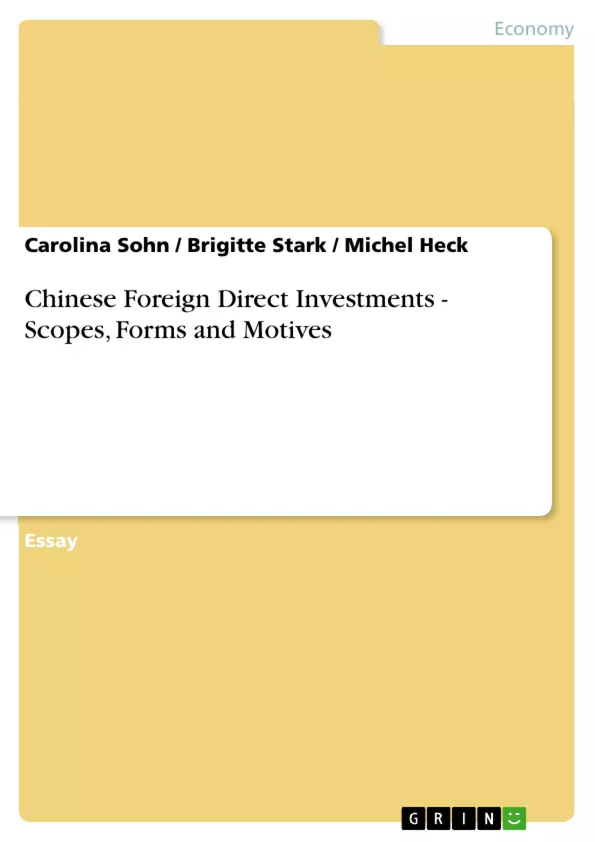Introduction
Since the initiation of economic reforms in 1979, China has become one of the world’s fastest-growing economies. From 1979 to 2004 China’s real GDP grew at an average rate of 9.3 %1 and many economists speculate that China could become the world’s largest economy at some point in the near future if the government continues and deepens its economic reforms. Moreover, trade continues to play a major role in China’s booming economy. In 2004, exports accounted for US$ 593 billion and imports for US$ 561 billion which makes China the third-largest trading economy worldwide.2 China’s trade boom is largely due to the inflow of foreign direct investment (FDI).
Most people know that China is a magnet for FDI and that it attracts more than any other country. In 2003 mainland China surpassed the United States as the largest FDI recipient. One year later the FDI inflow reached US$ 61 billion3 resulting in a cumulative level of FDI of US$ 563 billion4 at the end of 2004. Looking at these figures and at the “China fever” of managers from all over the world it is not very astonishing that for the last five years at least the big story has been about China’s FDI inflows. But there is another story as well. It is hardly mentioned in the press but it is becoming more and more important: the increase of Chinese FDI outflows.
For this reason the essay on hand shows, based on a general definition of FDI, the scope of China’s FDI outflows through current data and categorizes the different forms of FDI. Furthermore, the motives of Chinese companies investing abroad as well as the governmental actions supporting the going global movement are analysed. Then Chinese FDIs are examined in great detail at the example of Germany. Finally, problems of the development are discussed and the essay concludes with an outlook about China’s future FDI outflows.
---
1 cf. Morrison, Wayne M. (2005): China’s Economic Conditions, http://www.fas.org/sgp/crs/row/IB98014.pdf, 24.10.2005.
2 cf. ibidem.
3 cf. UNCTAD (2005): World Investment Report 2005, http://unctad.org-wir05_fs_cn_en.pdf, 13.10.2005.
4 cf. Morrison, Wayne M. (2005), 24.10.2005.
Inhaltsverzeichnis (Table of Contents)
- INTRODUCTION.
- DEFINITION: FOREIGN DIRECT INVESTMENT.
- SCOPE OF CHINESE FDIS.
- FORMS OF CHINESE FDIS.
- MOTIVES BEHIND CHINESE FDIS
- GOVERNMENTAL ACTIONS..
- CHINESE FDIS IN GERMANY
- PROBLEMS AND OBSTACLES
- OUTLOOK
Zielsetzung und Themenschwerpunkte (Objectives and Key Themes)
This essay examines the rising trend of Chinese foreign direct investment (FDI) outflows. It aims to define FDI, analyze the scope and forms of Chinese FDI outflows, explore the motives behind these investments, and assess the role of government support in promoting globalization. The essay then focuses on the case of Chinese FDIs in Germany, analyzing challenges and obstacles faced by Chinese companies investing abroad. Finally, it provides an outlook on the future of Chinese FDI outflows.
- Definition and scope of Chinese foreign direct investment (FDI) outflows.
- Forms of Chinese FDI, including joint ventures, greenfield investments, and subsidiary establishment.
- Motivations behind Chinese FDI, including market access, resource acquisition, and technological advancement.
- Governmental actions supporting Chinese FDI outflows, such as providing incentives and promoting internationalization.
- Analysis of Chinese FDIs in Germany and the challenges encountered by Chinese companies.
Zusammenfassung der Kapitel (Chapter Summaries)
- Introduction: This chapter provides an overview of China's rapid economic growth and the increasing importance of foreign direct investment (FDI) in its development. It introduces the essay's focus on the rising trend of Chinese FDI outflows.
- Definition: Foreign direct investment: This chapter defines the term "foreign direct investment" according to the International Monetary Fund, highlighting the key characteristics of FDI as an investment with lasting interest and significant influence on the management of the foreign enterprise.
- Scope of Chinese FDIs: This chapter examines the growth of Chinese FDI outflows since 1979. It highlights the significant increase in Chinese investment abroad, its ranking as a major overseas investment power, and the industries and regions targeted by Chinese FDIs.
- Forms of Chinese FDIS: This chapter explores the various forms of Chinese FDI, such as joint ventures, greenfield investments, and the establishment of subsidiaries. It analyzes how these different forms allow Chinese companies to expand their operations and presence in foreign markets.
- Motives behind Chinese FDIS: This chapter investigates the motivations driving Chinese companies to invest abroad, including market access, resource acquisition, technological advancement, and seeking new growth opportunities.
Schlüsselwörter (Keywords)
This essay focuses on the key concepts of Chinese foreign direct investment (FDI) outflows, including their scope, forms, motives, and governmental support. It also explores the challenges and opportunities associated with Chinese FDI, particularly in the context of Germany, highlighting the importance of understanding the factors driving globalization and internationalization.
- Quote paper
- Carolina Sohn (Author), Brigitte Stark (Author), Michel Heck (Author), 2005, Chinese Foreign Direct Investments - Scopes, Forms and Motives, Munich, GRIN Verlag, https://www.grin.com/document/51698



